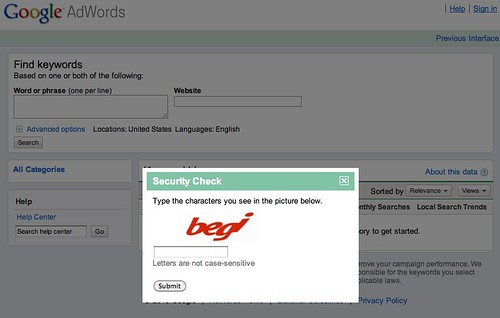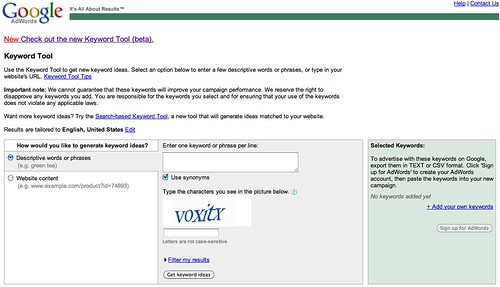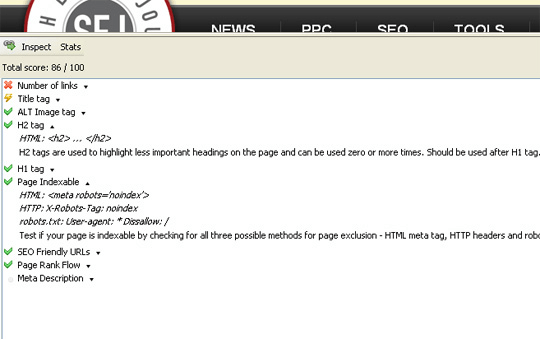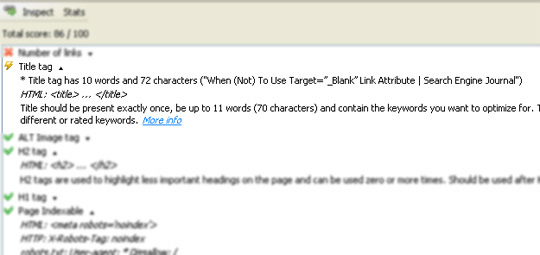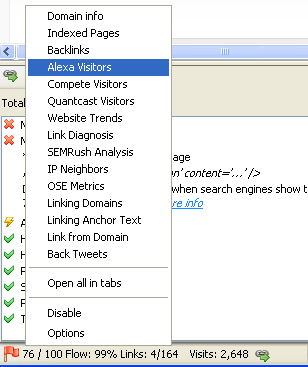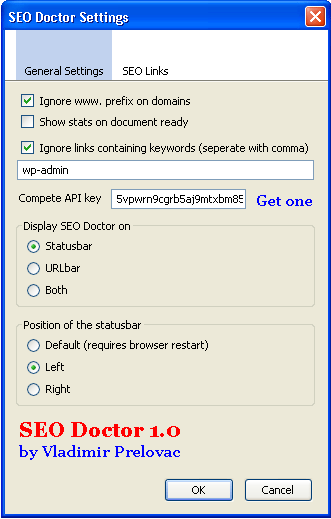Understanding thy competition is a golden rule in any kind of business, ranging from online marketing to politics to running the local mom & pop corner grocery store.
I would like to reprint some competitive intelligence tactics that I previously put together here on Search Engine Journal that will also be helpful.
Understanding what your competitors are doing online is a must and absolute priority when launching a new website that is entering a competitive space and also when established websites want to keep an eye on their competition. By knowing what your rivals are doing in their SEO and social media space, not only will you have a better knowledge of their online marketing strategy, but you can also emulate what is working for them, and generate internal ideas to stay proactive.
Furthermore, by understanding what your competition is doing in terms ofon-site SEO, link building, social media marketing, developing third party properties and other search marketing tactics; you can also identify potential new threats which are making it up the rankings and also unearth tactics which are working from them (or not working for them), that you can improve upon, and thrive from in your overall marketing strategy.
And doesn’t everyone love playing spy every once in a while?
Identifying the Competition
The first step in identifying your online competition is checking out the search results for your most popular keywords. Do not look only at keywords which drive the most traffic, but also your longtail keyterms and also the keyterms which convert the most sales, leads or phone calls.
By comparing the sites which you compete with in these various groups of keyterms, you will more or less identify different styles of competition that you can learn from and monitor. Here are some types of sites which may not appear for your basic keyterms in the serps, that you need to monitor.
- Affiliate sites are your competition. Not only sites which run the affiliate ads of your rivals, but also your own affiliate ads, because if they are ranking above your company’s site, they are taking money out of your pocket (or the search division’s pocket) by driving traffic and sales that you should be driving. Furthermore, affiliates don’t have to deal with internal regulations and beauracracy, so they can more or less get away with more tactics like publishing loads of content, paid linking, and taking full advantage of the social media outlets your management or PR division is not letting you tackle. Affiliates are the ninjas, mercenaries and dark armies of your industry, learn from them.
- Offline competitors sometimes don’t do the best SEO, maybe they just launch a flash site or brochure page and don’t rank at all, but they may have an advertising agency with a massive creative team building up their social media presence, hold contests or sweepstakes, build up Facebook followings, have a massive PPC budget and spend a lot of money on site advertising and sponsorships. By monitoring what the do in online advertising, you can identify keyterms and copy which work for them in their PPC campaign and also find out the sites or networks where they are serving graphic advertising, and contact those same networks about striking a deal which will assist with your SEO or linking. If your competition is serving ads there, then those sites hit your target market.
On-Site Competitive Intelligence
Now that you have identified the sites you need to monitor as part of your competitive intel strategy, now start looking into the on-site factors which help them rank in the search engines. You may find not only what they are doing right, but what you are doing wrong. When performing a competitive intel report, I suggest including your own site in the report and even having a third eye, like an SEO consultant or internal staff member, do the research on your own site.
- Site URL Structure : By tracking the URL structure and file naming structure of competitors, you can determine the best route to gain a competitive advantage over other companies.
- Site Development and Coding Structure : Which language is the site being coded in. Are there any conflicts in programming language or separate IP’s? This information is vital to SEO competitive intel.
- Use of Analytics : Is the competitor tracking user behavior and referrals via Google Analytics, Hitbot, Omniture? Looking into their analytics systems help give an idea of how much information they are capturing from their visitors and how advanced their internal tracking is – which may define how advanced their SEO team is.
- The directory files and URL structures of listings pages : This will be used to determine which techniques these competitors are using for their individual pages, their content, meta and URL structures, and how these reflect in the Google, Yahoo and MSN rankings.
- Page Title and META Title Review: Page titles are one of the most influential HTML elements used in an optimization campaign. Since the optimization of this variable is connected to rankings and actual links in the Search Engine Results Pages (or “SERPs”), an analysis has been conducted to provide which sites use a preferred title structure and which just use repetition of their company name.
- META Tag Review (Description / Keywords): META tags have limited relevance to rankings, but do play a part in that search results often feature the META Description tag. Knowing this, an optimized description that instigates action from the searcher is preferred. Further, integrating the targeted keywords allows for them to be bold or otherwise emphasized in the listings – which helps to convert more clicks in the SERPs through to the optimized site.
- Navigational System Review: Search engines spider, or seek out new content based on the links they find to resources on a page. Navigation systems are the most consistent manner for building internal link popularity, so research evaluates the overall strength of these systems used. For example, a Flash based navigational system is horrible for SEO, whereas consistent keyword driven links with keywords integrated are optimal.
- Broken Links : If a site has broken links, broken files or lists non-existant pages, then Google will lower the ranking of that site because the engine believes that the site is under construction. Run a link check using Xenu Link Sleuth to see if your competition is overlooking such linking and internal navigation issues.
- HTML Code Validity: Using the W3C Validation tools, your competitors’’ web sites have been reviewed. This allows the engines to promote sites that deliver a consistent and predictable user experience. Run each site through the validation tool, and reported back the number of errors noted.
- Design & SEO Integration: Similar to the internal navigational structure, the use of some HTML elements are preferred over others for SEO purposes. Our research and analysis of competing site designs have been provided in this document.
Offsite Competitive SEO Elements
Not only do onsite tactics assist with the ranking of a website, but sometimes more importantly offsite tactics can benefit the competitive advantage to boost a site from the bottom of the front page on Google, to the top three traffic driving positions.
By monitoring offsite SEO tactics, and social media tactics, you can get a rounded feel for the link building strategies your competitors are using, their participation in blogs, sites they may own which are harnessing social media equity and directing it to their main site, if paid linking is working for them, and how they’re doing on Delicious, Digg and in vertically targeted social networks. All of these factors have a direct influence on search engine rankings and you will not only learn what your competition is doing, but what they are not. And by identifying these holes, oversights or even genius ideas… and applying them to your marketing strategy, you can further excel within your industry.
- Local Listings : Determine the local SEO listings that your competition has made on Yahoo Local, Citypages, BOTW Local, MSN Live and other local search engines or local profiles. These differ from the results shown in organic web search sometimes and can be an indicator of local seo techniques used or overlooked by the competition.
- Number of Inbound Links: Using Yahoo! Site Explorer, report on the number of inbound links to each of the analyzed web sites. As a rule, the more links and the more relevancy – the better. Search Engines like Google use inbound links to help shape the overall level of authority of a web site.
- Linkbait or Viral Marketing : How are these competitors building links? Are they running link baiting programs and actively having articles submitted to Digg & StumbleUpon? Are they using any Viral Marketing techniques like videos, widgets or badges which link back to them and assist with their rankings. Dig into their campaigns to find out what they are using, and monitor the social networks to identify future social linking campaigns.
- Social Media : Do they actively use social media to market their business? Does their company have a Wikipedia page? How do they rank for their own brand name and are social profiles served in these results? Have they even secured their brand across social networks? Do they distribute online video? This research will help determine a social media plan and also identify competitive advantages that you can use to your advantage.
- Blogging : Do these companies blog and who is doing their blogging? Are the blogs on a subdomain, a whole other website or in an internal directory file. How often do they post? How many subscribers will they have? This information will assist you construct your blogging strategy and possibly unearth some ideas.
- Paid Link Research: It is difficult to say with certainty that an inbound link has been purchased. There are however signs where common systems like Paid Directories and Link Networks are used on a site. Research of inbound, paid links to your competitors from sidebars, ads on newspaper sites or bad paid linking in footer links may give you some insight as to which anchors they are targeting and what is working for them.
- Site visits and Traffic : Using a mix of data from Alexa, Compete and other web traffic estimation tools, estimate the traffic of the competitors in terms of visitors, time spent on site, top referrals and other information driven by third party tools.
- Page Rank and other Metrics : Compile a list of competitive metrics including Google PageRank, SEOmoz PageStrength, Delicious Bookmarks, StumbleUpon voting, Google Page Indexing, Google Competitive Indexing.
- Competitive Rankings : Last but not least, run a ranking check using a search engine friendly software for each of the terms which you have determined for targeted SEO keyterms via your comeptitive research. Check the rankings for these sites and terms in Google, Yahoo, Ask.com, Bing and maybe some engines which are used specifically by your industry.
This may sound like a lot of information to monitor, and you’ll probably want to add more industry specific metrics to your research dependent upon how SEO savvy your market is. But in the long run by documenting this information now, and revisiting it once a quarter, you will have a pinpoint idea of the tactics your search rivals are utilizing, what they are not, and even what they are picking up.
If you need any help with the tools needed to perform a lot of this research, please contact me via email or Twitter (in my profile box at the top of this post) or check out our SEO Tools post for some ideas.
Are there any other competitive intel tactics you recommend? Please feel free to share them in the comments below.

